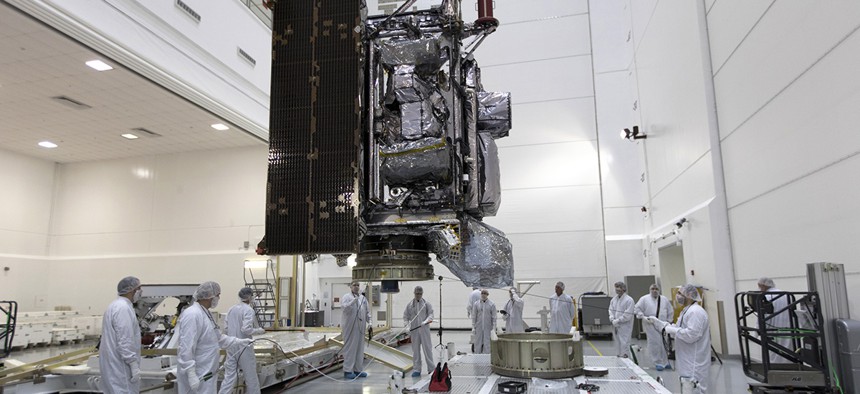NOAA’s Newest Weather Satellite Isn’t Working Right

Technicians and engineers move NOAA's Geostationary Operational Environmental Satellite-S (GOES-S) to a work stand at Astrotech Space Operations in Titusville, Fla. NASA/AP
The satellite's “premiere” instrument gets too hot at night and engineers are struggling to find out why.
One of the sensors on the government’s newest weather satellites is largely blind half the day, according to National Oceanic and Atmospheric Administration officials, who said tests on its GOES-17 satellite have shown problems with one of the cooling systems.
GOES-17—launched March 1 and currently in its initial check-out period—is outfitted with four space weather instruments, a lightning mapper and an instrument called the Advanced Baseline Imager.
ABI provides the core functionality for NOAA’s next-generation environmental satellites, which include GOES-16—currently in operation—and GOES-17, as well as GOES-T and GOES-U, with planned launches in 2020 and 2024, respectively.
The instrument provides images of weather patterns in the Western Hemisphere across 16 spectral bands, from visible light to infrared. Using these variations in measurement, the system can provide a detailed picture of current weather patterns, including the height of wind systems.
During the check-out procedures, NOAA engineers discovered a problem with the cooling system supporting the 13 infrared bands. Due to the satellite’s location and positioning of the lens, the ABI system cannot function during nighttime hours, severely degrading the data that can be collected.
“This is a serious problem,” Steve Volz, administrator of NOAA’s National Environmental Satellite, Data and Information Service, or NESDIS, said during a May 23 briefing with reporters. “This is the premier Earth-pointing instrument on the GOES platform and the 16 channels…are important elements of our observing requirements.”
The lack of nighttime data from this satellite would mean a loss of accuracy in weather models, were the system to go online today.
The GOES-R constellation is being heralded as a significant step forward in NOAA’s ability to track weather systems, as well as an answer to an impending gap in satellite coverage. Progress on the GOES-R program prompted the Government Accountability Office to remove the geostationary gap from its biennial high-risk list in 2017. GAO researchers have asked for a briefing on the latest developments.
Short-term delays for GOES-17 will not affect weather monitoring, according to NOAA officials, as the GOES-16 satellite in conjunction with the older GOES-15 and GOES-14 are currently covering North America.
Representatives from Harris Corp., the vendor that built the ABI system, confirmed the malfunction and said they are currently troubleshooting the issue along with NOAA and NASA, but have yet to identify the cause of the problem.
Prior to launch, “We conducted comprehensive performance tests of the instrument, including testing it to the vibration, thermal and electromagnetic environments above what it would see during launch and on orbit,” Kristin Jones, a senior communications manager with Harris, told Nextgov. “The instrument’s performance was reviewed and approved as flightworthy by Harris, NASA and an independent review team.”
Harris Corp. also confirmed that the same cooling system was used for GOES-16, which is currently fully operational.
The satellite and its other systems—the five other instruments and ABI’s three visible band sensors—are still operational and will still be useful if engineers are unable to get the cooling system operational, according to Joe Pica, director of NOAA’s Office of Observations within the National Weather Service.
“We are getting degraded performance on the infrared and near-infrared channels—not zero performance but degraded,” Volz said. “We still have a highly capable, functioning spacecraft and mission, even under the current operating conditions that we’re seeing in the initial test period.”
NOAA officials are also looking at potentially moving up the launch of GOES-T, if required, though it is too early to speculate on those options, Volz added.
But that’s the worst-case scenario.
The six-month check-out period goes until August, giving the team another three months to diagnose the problem and determine whether it can be fixed before the GOES-R program is off schedule.
“It’s gonna be a busy summer for us,” Volz said.






